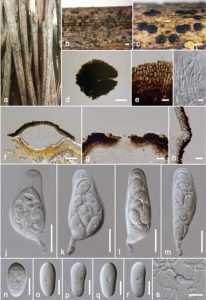Muyocopron castanopsis Mapook, Boonmee & K.D. Hyde, sp. nov., Index Fungorum number: IF 551616
Etymology: Named after the host genus Castanopsis.
Holotype: MFLU 15–1131
Saprobic on dried twigs of Castanopsis indica (Roxb.) Rehder. Sexual morph: Ascomata (140–)170–250 µm high × 450–750 µm diam. (x̅ = 196.5 × 562 µm, n = 5), superficial, solitary or scattered, coriaceous, appearing as circular, scattered, flattened, brown to dark brown spots, covering the host, without a subiculum, with a poorly developed basal layer and an irregular margin. Ostiole central. Peridium 25–35 µm wide, widest at the sides, outer layer comprising dark brown to black, pseudoparenchymatous, occluded cells of textura angularis, inner layer comprising light brown cells of textura angularis. Hamathecium comprising 1.5–2.5 µm wide, cylindrical to filiform, septate, pseudoparaphyses. Asci (85–)95–110 × 23–24(–28) µm (x̅ = 98 × 24 µm, n = 10), 8-spored, bitunicate, saccate or broadly obpyriform to ovoid, pedicellate, straight or slightly curved, with an ocular chamber. Ascospores 20–26 × 10–13 µm (x̅ = 23 × 11.5 µm, n = 20), overlapping 2–4 seriate, hyaline, ellipsoid to obovoid, with obtuse ends, aseptate, with granular appearance. Asexual morph: Undetermined.
Culture characteristics: Ascospores germinating on MEA within 24 hr. at room temperature and germ tubes produced from both ends of the ascospores. Colonies on MEA reaching 0.8 cm diam after 1 week, at 25 oC. Aerial mycelium initially white, slightly raised, in old cultures grayish to light brown, flattened on surface, brown to dark brown from below, margin light brown to white.
Material examined: THAILAND, Chiang Rai, on dried twigs of Castanopsis indica (Fagaceae), 22 July 2014, A. Mapook, (MFLU 15–1131, holotype), ex-type culture MFLUCC 14–1108, BCC; ibid. (HKAS92522, isotype); on dried twigs of Castanopsis indica (Fagaceae), 26 August 2014, A. Mapook (MFLU 16–0476, paratype)
Notes: Muyocopron castanopsis is a saprobe on dried twigs of Castanopsis indica (Roxb.) Rehder. Our collection is most similar to Muyocopron hongkongense in size and shape of the ascospores, but it differs in having larger ascomata ((140–)170–250 × 450–750 µm vs. 220–440 × 92–160 µm) and longer ascospores and different host families (Fagaceae vs Arecaceae). Thus, we consider our collection to be a new species based on morphology.
Fig. 2. Muyocopron castanopsis (holotype). a–c Superficial ascomata on substrate. d–e Squash mounts showing ascomata walls. f Section of ascoma. g Ostiole h Peridium. i Pseudoparaphyses. j–m Asci. n–r Unicellular ascospores. s Germination of ascospore. Scale bars: b,c = 500 µm, d = 200 µm, g = 100 µm, j–m = 20 µm, e, h, i, n–s = 10 µm, f = 5 µm.

